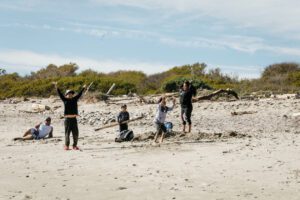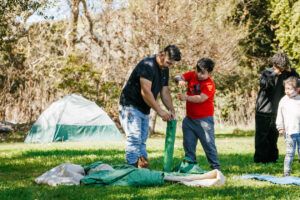One of the best parts of my job is working with our network of nonprofit grantees to create long-lasting solutions. Oftentimes, we are figuring out ways to address complex, systemic issues by leveraging innovative new tools and programs in order to make extraordinary things happen for communities across California.
Our Route to Parks grants program is a great example of how Parks California partners with State Parks and nonprofits to address intrinsic challenges faced by people from historically marginalized communities. With 280 incredible state parks across California – including beaches, deserts, mountains, lakes and other green spaces – our parks offer an abundance of opportunities to learn from and to explore. However, documented disparities, such as the lack of transportation or public transit options can be a barrier to fostering personal connections with the outdoors.
We launched the Route to Parks grants program in 2020 to support and fund local organizations that are best able to address transportation and other obstacles to getting to and enjoying parks. We’re currently in our third cycle, and last week we officially launched the application process for the 2024 cycle – our fourth year of the Route to Parks grants program! And, working with our partners at State Parks, we are so excited to expand the program to include an emphasis on inland waterways and lakes next year.
But the question I often get is, “how do you know these programs are working?” It’s a great question.

MEASURING OUR IMPACT
Evaluating our programs to ensure they are creating positive change and meeting the needs of our communities is a critical part of our internal process. For Route to Parks, we conduct evaluations of each grant cycle, so we reviewed the results from the first two years to inform our current operations as well as future grants cycles.
What did we find? Let’s look at where we started.
In our first year, we awarded yearlong Route to Parks grants to 21 nonprofits and, in its second year, we provided grants to 19 nonprofits. All grantees are required to serve populations who have historically had less access to State Parks and may face transportation barriers to accessing outdoor spaces.
In Year 1 and 2, these 40 organizations served over 9,000 people – 79% who had never visited a state park before – and made 88 visits to 56 State Parks or State Beaches. Grantees traveled near and far to visit outdoor spaces, with 81% of the visits made within 60 miles of the organization’s home base, and 19% of visits to parks more than 60 miles away!
Although all 40 nonprofits used grant funding to support transportation costs, each organization provided a unique model for increasing access to State Parks and the outdoors. Some grantees provided short experiences to a large number of participants, while others provided multi-day, intensive experiences to a small group. Grantees are encouraged to design programming that meets the needs of local participants, such as offering bilingual resources, to ensure participants enjoy their visits.
For many, the program connects people to new experiences. One participant told us: “Something that I did that surprised me was that I could actually sleep outside for the night. Because I’ve never done that before so I thought it was gonna be bad but I felt good. I used to feel nervous about sleeping outside because of the strange people and animals but now I feel confident that I can do it.”
Whether it was an overnight camping trip or a day-long excursions, participants enjoyed a range of activities such as team-building, hiking, swimming, or learning about climate conservation, protecting wildlife habitat and cultural history.
When we surveyed these organizations, 93% of these nonprofits told us that transportation funding is essential to the delivery of their programming. In fact, most expressed this as “absolutely essential.”
Grantees located in more rural areas such as the Central Valley, Central Coast, and Northern California unanimously expressed that young people were unable to rely on public transportation as a method for accessing green spaces and many do not have access to a personal vehicle to travel the distances necessary to reach outdoor spaces. Schools also struggle to pay for buses to bring students to outdoor spaces. Grantees reported that transportation continues to be a significant barrier to accessing the outdoors for low-income families, and having funding dedicated to transportation was critical to increasing outdoor access.
In the first two years, grantees leveraged their grants to do a lot more than covering the cost of parking and admission fees.
Approaches to transportation solutions were varied and unique to the location of the organization and the community’s needs. We loved seeing how grantees demonstrated creativity in resolving transportation barriers to outdoor spaces! For instance, one organization was able to make a significant impact for wheelchair users by not only reducing transportation barriers to get to the outdoors but also increasing trail access once at the park! NatureTrack used the grant funds from us to charter ADA buses to transport wheelchair users to and from parks and also purchased and delivered Freedom Trax, a motorized off-road attachment for manual wheelchairs that allows for travel, exploring, and getting off the beaten path. For some participants, this was the first time they were able to access the outdoors since they’d started using a wheelchair.

A LIFE-LONG CONNECTION
Our evaluation found that Route to Parks contributed to three primary outcomes: reducing transportation barriers for economically disadvantaged groups to visit parks, cultivation of lasting connections to the outdoors for participants, and strengthened relationships between nonprofits and California State Parks.
Ultimately, we want Route to Parks to be a starting point for each person to create their own life-long relationship with parks and the outdoors. In surveys, 96% of participants told us they wanted to return to a park in the future.
For me, this is proof that the Route to Parks grant program is a great investment in our parks and our future. But don’t take my word for it….
A young participant said, “I want to come back to this place. This exact spot right here. I cannot wait to bring my family and friends to this place and have them experience what I did here. This was such a blast.”
A parent added, “Now I know where I can bring my son by myself and I can come back here again.”
And a teacher told us, “That was the best field trip ever! The kids were so happy and I know many want to bring their families on the weekends. Some said they want to work there! The bilingual piece was fantastic. It is so good for them to hear their native language in settings like this and see how it can be used professionally and not just at home, church, or on TV which is where they mostly hear Spanish. It is a powerful lesson for all but especially our girls to see strong, bilingual women using Spanish as well as English in their careers.”
LAUNCHING OUR 2024 GRANT CYCLE
We’ve just begun to roll-out the grant application process for 2024, and I can’t wait to see what our new grantees will do! Detailed information about the application process and eligibility criteria is available on our website. And we will be hosting a webinar on August 3, 2023 to discuss Route to Parks Grants goals and address common questions regarding the application process. Potential applicants are encouraged to attend although it is not required that you be on the webinar to submit a proposal. Register for the webinar at this link.
We’re grateful for the support we’ve received from private donations made to Parks California and to our contracts with the California Department of Parks and Recreation’s Waterway Connections Initiative, which enable us to run this incredible program. As we continue to grow Route to Parks, additional funding support will determine the number and size of grants we can give. If you are interested in making an investment in helping people get to and experience parks, please consider a donation to the Route to Parks program (click the orange “Donate” button at the top of this page and write “Route to Parks” in the comments).
Myrian Solis Coronel is Parks California’s Director of Community Engagement. The Route to Parks grants program is aligned with the goals of California Natural Resources Agency’s Outdoors for All program. Through this partnership, Parks California aims to improve park access for everyone so we can all create authentic connections with nature.


